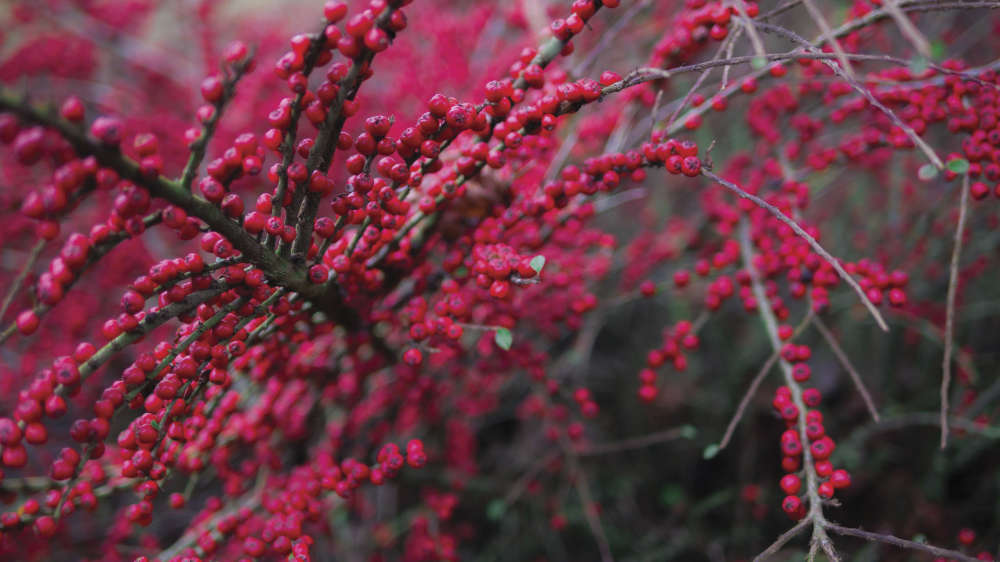
Summer's on the run – but there's still plenty of colour to be had in the garden. Flo Whitaker chooses six of the best shrubs for autumn
The cornus family is a diverse, extensive tribe, containing varieties such as ‘Midwinter Fire’ and ‘Anny’s Winter Orange’. With names like that, you don’t need to be familiar with the genus to realise that no autumnal border is complete without them. Some varieties can become large, so, if space is limited, choose types, (such as the above), that tolerate being cut back hard, (about 5cms above soil level) in spring. An annual haircut will keep them under control and also maintain the best stem colour.
Hydrangeas papery blooms are a quintessential part of autumn, but Hydrangea quercifolia goes one stage further, bearing unusually large oak-leaf shaped leaves in glowing red and russet shades. Mature plants reach a substantial size and are often as wide as they are tall, (approx. 2 metres).
Hardworking hardy fuchsias will keep on blooming until the first frosts and are undemanding, although moist soil in light shade is their preferred location. Elegant ‘Hawkshead’, with slender white flowers lights up a dull corner, whereas ‘Mrs Popple’, (an old Victorian variety) bears plump flowers in jewel-like ruby and purple. Hardiest of all fuchsias are the tall ‘hedging’ forms. They make sizeable bushy plants with good looking autumnal foliage and live practically forever.
Euonymus, or ‘Spindle’, (so-called because its wood was used to make thread spindles) is a star of autumn, with deciduous foliage in a bonfire blaze of colours and extraordinary winged fruits on fine, trembling stems. Euonymus makes a large, multi-stemmed plant or small tree and is indigenous to northern Europe – you may notice the native form growing in Sussex hedgerows. There are also many garden varieties to choose from.
Cotoneaster horizontalis is considered old-fashioned these days, but please ignore such nonsense. Its visually-arresting stems make herringbone patterns, fanning upwards and outwards, with tiny leaves in darkest green. Come summer, dainty, nectar-rich flowers attract every bee in the neighbourhood. Late autumn brings a fiery display of berries, as the foliage reddens and falls, revealing a wintry skeletal outline. It really is a plant for all seasons.
Members of the cotinus family, often regarded as a boring municipal planting choice for soulless car parks and traffic islands, have much to offer. Given good, moisture-retentive soil, cotinus thrives for years and offers a long season of interest. An open, sunny spot will produce the best leaf colour. Some forms reach substantial proportions, but they respond well to cutting back in spring – if you’re a keen flower arranger, an annual prune also has the advantage of keeping the leaves smaller. Known as ‘Smoke Bush’, cotinus produce eye-catching plumes of flowers in summer, but autumn is when they really sing, with foliage in shades of coppery brown to deep plum; nicely complimenting other autumn lovelies such as dahlias and chrysanthemums.


 Blooming Times: Happy Faces
Blooming Times: Happy Faces
 Blooming Times: Winter Sparklers
Blooming Times: Winter Sparklers
 Homes Extra: Restore, Repair, Recycle
Homes Extra: Restore, Repair, Recycle
 Home Style: A Scandi Winter's Tale
Home Style: A Scandi Winter's Tale
 Blooming Times: Winter Wonders
Blooming Times: Winter Wonders
 Home Style: Bold, Brave & Beautiful
Home Style: Bold, Brave & Beautiful
 Blooming Times: The Answer Lies in the Soil
Blooming Times: The Answer Lies in the Soil
 Blooming Times: Heavenly Hyacinths
Blooming Times: Heavenly Hyacinths
 Legendary Builds with Phoenix Construction Services
Legendary Builds with Phoenix Construction Services
 Blooming Times: Know Your Enemy
Blooming Times: Know Your Enemy
 Bespoke Dreams from Eridge Green Kitchens
Bespoke Dreams from Eridge Green Kitchens
 10 Hot Years: iFit Fires & Flues
10 Hot Years: iFit Fires & Flues
 Home Style: Bold Type
Home Style: Bold Type
 Blooming Times: The Sky's the Limit
Blooming Times: The Sky's the Limit
 Home Style: A Better Way of Life
Home Style: A Better Way of Life
 Homes Extra: Shed Space
Homes Extra: Shed Space
 Blooming Times: Top of the Pots
Blooming Times: Top of the Pots
 Kids Zone: Get the Kids Growing
Kids Zone: Get the Kids Growing
 Home Style: Pastures New
Home Style: Pastures New
 Homes Extra: Let There Be Light
Homes Extra: Let There Be Light